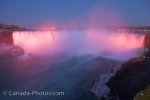Northwest Territories Photos
The vast region of the Northwest Territories is a photographers paradise, with plenty of opportunities to take pictures of untouched wilderness, wildlife and arts and culture. Below is a selection of our Northwest Territories Photos and Pictures. (There are 2 photos in this photo gallery.)
The Northwest Territories border the Yukon to the west, Nunavut to the east, and the provinces of British Columbia, Alberta and Saskatchewan to the south. The largest centers are Yellowknife, Inuvik and Hay River. Yellowknife is known as the diamond capital of North America, and diamond mining is an important sector of the economy. Half of the territories population is made up of native Dene and Inuit peoples, whose presence dates back thousands of years.
The territories are made up of boreal forest, mountains, lakes, rivers and arctic tundra. ... ...continue under photos...
A curious caribou also called reindeer, or scientific Rangifer tarandus in the Northwest Territories, Canada, North America.
An antlered caribou, Rangifer tarandus, reindeer, Canada, North America. Arctic Northwest Territories
Also known as the Igloo Church, Our Lady of Victory Roman Catholic Church, is situated in Inuvik in the Northwest Territories, Canada.
Our Lady of Victory Roman Catholic Church, The Igloo Church, Inuvik, NWT, Canada, North America.
... Photographers may get a chance to take pictures of the abundant wildlife, including polar bears and grizzly bears, moose, muskox, Dalls sheep, beluga whales, and many birds. Some of the more spectacular sights are the massive migration of caribou.
Visitors to the territories will wish to explore its natural wonders and national parks. Nahanni River National Park, a UNESCO world heritage site, is popular for canoeing and white-water rafting. Canoeists also like to paddle the mighty Mackenzie River.
Tuktut Nogait is the territories most recent park. Here, one can witness the awe-inspiring caribou migration, or visit archaeological sites. Aulavik National Park, on Banks Island, is a great place to see Muskox. Wood Buffalo National Park, one of the largest parks on earth, is home to the Wood Buffalo, and is the nesting site of the endangered Whooping Crane.
The Northwest Territories have some very large lakes, namely Great Slave Lake and Great Bear Lake. The former is one of the largest and deepest freshwater lakes in the world. The lakes are popular for boating and fishing.
Keep the camera ready for northern lights, panoramic scenery, wildlife and all of the wilderness adventures that await on a visit to the Northwest Territories.



